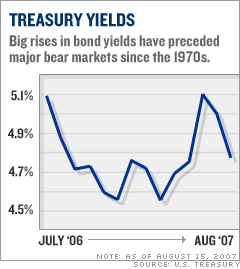Happened yet? Not really
Big market pullbacks tend to take place after jumps in the yield of the 10-year Treasury note. Bear markets in the mid-'70s, early and late '80s, early '90s and 2000 all followed significant rises in bond yields. For example, the yield on the 10-year surged from 7 percent in January 1987 to 10.2 percent just before the October crash.
What about now? The 10-year yield rose from about 4.5 percent in mid-March to 5.2 percent in June but dropped back to around 4.7 percent in mid August.
"If the yield on the 10-year went up to 6 percent," says Jeffrey Saut, chief investment strategist for Raymond James Financial, "that could change investor psychology" - and help send the bull packing.
The state of the dollar affects Treasury yields too. A weakening dollar makes foreign investors nervous about holding Treasuries; when they sell, Treasury prices fall and yields rise.
"That would hit stocks, just like in 1987," says Subodh Kumar, an independent market strategist. The dollar has sagged - from $1.29 to the euro at the beginning of the year to $1.34 to the euro in mid August. If it slips further, that's a warning sign, Kumar says.

